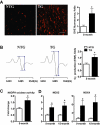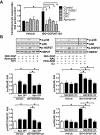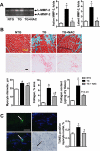Myocardial oxidative stress contributes to transgenic β₂-adrenoceptor activation-induced cardiomyopathy and heart failure
- PMID: 20955367
- PMCID: PMC3051376
- DOI: 10.1111/j.1476-5381.2010.01043.x
Myocardial oxidative stress contributes to transgenic β₂-adrenoceptor activation-induced cardiomyopathy and heart failure
Abstract
Background and purpose: While maintaining cardiac performance, chronic β-adrenoceptor activation eventually exacerbates the progression of cardiac remodelling and failure. We examined the adverse signalling pathways mediated by nicotinamide adenine dinucleotide phosphate (NADPH) oxidase and reactive oxygen species (ROS) after chronic β₂-adrenoceptor activation.
Experimental approach: Mice with transgenic β₂-adrenoceptor overexpression (β₂-TG) and non-transgenic littermates were either untreated or treated with an antioxidant (N-acetylcysteine, NAC) or NADPH oxidase inhibitors (apocynin, diphenyliodonium). Levels of ROS, phosphorylated p38 mitogen-activated protein kinase (MAPK), pro-inflammatory cytokines and collagen content in the left ventricle (LV) and LV function were measured and compared.
Key results: β₂-TG mice showed increased ROS production, phosphorylation of p38 MAPK and heat shock protein 27 (HSP27), expression of pro-inflammatory cytokines and collagen, and progressive ventricular dysfunction. β₂-adrenoceptor stimulation similarly increased ROS production and phosphorylation of p38 MAPK and HSP27 in cultured cardiomyocytes. Treatment with apocynin, diphenyliodonium or NAC reduced phosphorylation of p38 MAPK and HSP27 in both cultured cardiomyocytes and the LV of β₂-TG mice. NAC treatment (500 mg·kg⁻¹ ·day⁻¹) for 2 weeks eliminated the up-regulated expression of pro-inflammatory cytokines and collagen in the LV of β₂-TG mice. Chronic NAC treatment to β₂-TG mice from 7 to 10 months of age largely prevented progression of ventricular dilatation, preserved contractile function (fractional shortening 37 ± 5% vs. 25 ± 3%, ejection fraction 52 ± 5% vs. 32 ± 4%, both P < 0.05), reduced cardiac fibrosis and suppressed matrix metalloproteinase activity.
Conclusion and implications: β₂-adrenoceptor stimulation provoked NADPH oxidase-derived ROS production in the heart. Elevated ROS activated p38 MAPK and contributed significantly to cardiac inflammation, remodelling and failure.
© 2011 The Authors. British Journal of Pharmacology © 2011 The British Pharmacological Society.
Figures








Comment in
-
β₂-Adrenoceptors, NADPH oxidase, ROS and p38 MAPK: another 'radical' road to heart failure?Br J Pharmacol. 2011 Mar;162(5):1009-11. doi: 10.1111/j.1476-5381.2010.01130.x. Br J Pharmacol. 2011. PMID: 21271996 Free PMC article.
References
-
- Ahmet I, Krawczyk M, Zhu W, Woo AY, Morrell C, Poosala S, et al. Cardioprotective and survival benefits of long-term combined therapy with β2-adrenoreceptor (AR) agonist and β1-AR blocker in dilated cardiomyopathy postmyocardial infarction. J Pharmacol Exp Ther. 2008;325:491–499. - PubMed
-
- Anrather J, Racchumi G, Iadecola C. NF-kappaB regulates phagocytic NADPH oxidase by inducing the expression of gp91phox. J Biol Chem. 2006;281:5657–5667. - PubMed
-
- Antos CL, Frey N, Marx SO, Reiken S, Gaburjakova M, Richardson JA, et al. Dilated cardiomyopathy and sudden death resulting from constitutive activation of protein kinase A. Circ Res. 2001;89:997–1004. - PubMed
-
- Bristow MR. β-adrenergic receptor blockade in chronic heart failure. Circulation. 2000;101:558–569. - PubMed
Publication types
MeSH terms
Substances
LinkOut - more resources
Full Text Sources
Medical
Research Materials
Miscellaneous

